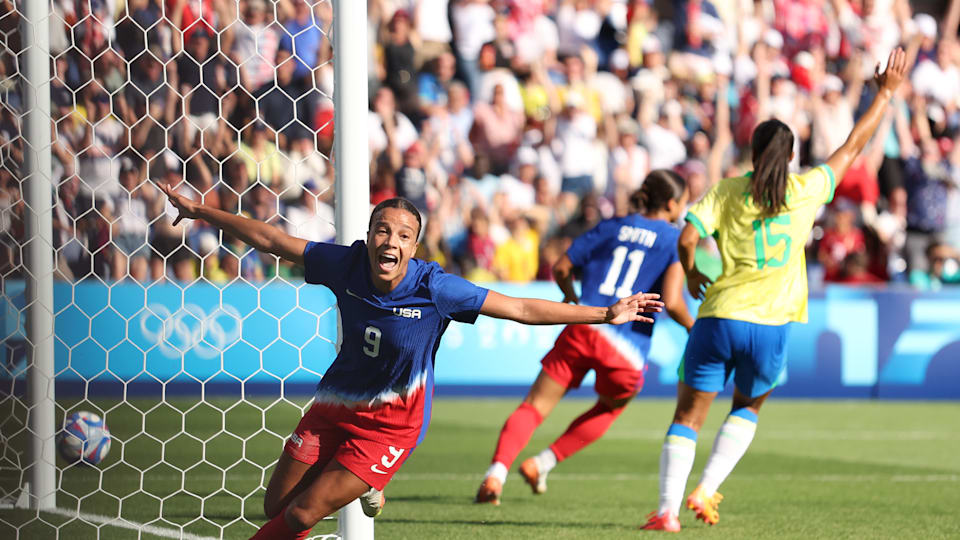 Champions League
Champions League

 Conference League
Conference League

 Premier League
Premier League

Published on Aug, 10 2024

In a momentous display of resilience and strategic brilliance, the United States Women's National Team (USWNT) secured their fifth Olympic gold medal with a narrow 1-0 victory over Brazil in the Paris 2024 final. This victory marked not just another feather in the cap for the USWNT, but a significant turning point in the team's evolution, orchestrated by head coach, Emma Hayes, whose bold decisions and fresh approach defined the tournament.
The Bold Move: Benching Alex Morgan
One of the most talked-about decisions leading up to the final was Coach Andonovski's choice to bench veteran forward Alex Morgan, a move that stunned fans and pundits alike. Morgan, a key figure in the USWNT for over a decade, was expected to lead the charge in what many believed could be her final Olympic appearance. However, Hayes had other plans, opting for an entirely new lineup that emphasized youth, speed, and tactical fluidity.
This decision was not without its risks, but it was rooted in a clear vision. Andonovski sought to rejuvenate a squad that had shown signs of stagnation in previous tournaments. By placing trust in the new generation, she aimed to inject fresh energy and a different dynamic into the team's play.
The New Faces: Youthful Energy and Tactical Flexibility
The Paris 2024 squad featured several new faces, many of whom had never played on such a grand stage before. Players like Sophia Smith, Trinity Rodman, and Naomi Girma were thrust into the spotlight, each bringing their unique skills and hunger to the pitch.
Offensively, the USWNT's shape was a blend of fluidity and precision. Smith and Rodman, both known for their pace and creativity, spearheaded a dynamic front line that constantly stretched Brazil's defense. The midfield, orchestrated by rising star Lindsey Horan, was the heartbeat of the team, dictating the tempo and linking play between defense and attack. Hayes’ tactical shift to a 4-3-3 formation allowed the team to maintain width, while also providing the flexibility for players to interchange positions seamlessly, keeping the Brazilian defense on their toes.
Defensive Solidity: A Fortress at the Back
Defensively, the USWNT was a fortress. With Girma and veteran Becky Sauerbrunn anchoring the backline, the team displayed a perfect blend of youthful exuberance and experienced composure. The defense was structured in a compact 4-2-3-1 shape when out of possession, with the full-backs, Emily Fox and Sofia Huerta, tucking in to support the center-backs, while also being quick to transition into wide positions during counterattacks.
Brazil, known for their flair and attacking prowess, found themselves stifled by the USWNT’s disciplined defensive unit. Every Brazilian advance was met with a well-timed interception or a perfectly executed tackle, frustrating their attempts to break through.
Team Harmony: A New Era of Unity
Beyond the tactical adjustments, one of the most striking aspects of the USWNT's campaign was the evident harmony within the squad. Hayes’ decision to integrate new players with seasoned veterans paid off, as the team displayed a unity that was palpable both on and off the pitch. The veterans provided mentorship and stability, while the newcomers brought enthusiasm and a fearless approach, creating a perfect blend of experience and youth.
This harmony was evident in the way the team celebrated each victory, with every player, whether on the pitch or the bench, contributing to the collective success. The benching of Morgan, rather than causing division, appeared to strengthen the team’s resolve, with Morgan herself seen constantly encouraging and guiding her younger teammates.
Hopes for the Future: A Bright Horizon
As the final whistle blew and the USWNT celebrated their hard-fought victory, it was clear that this was more than just an Olympic triumph; it was the beginning of a new era. The Paris 2024 Olympics showcased the depth and talent within the USWNT, proving that the future is in good hands.
Looking ahead, the challenge for Hayes and her squad will be to build on this success. The integration of young talent, combined with the experience of seasoned players, has set the stage for sustained dominance on the international stage. The question now is how this blend of players will continue to evolve and whether they can replicate their Olympic success in future tournaments, including the next World Cup.
In Paris, the USWNT did more than just win a gold medal; they redefined themselves, setting a new standard for what this legendary team can achieve. The world will be watching as this new chapter in USWNT history unfolds, with hopes high for continued success and perhaps, even more gold.
Editors Top Picks







